Menu

Standing in a big, green forest, life’s complex web became clear to me. The leaves, creatures, and the wind all told a story of balance. Now more than ever, we must protect biodiversity. This is our duty to the planet and our shared future.
Published in June 2018, the Sustainable Biodiversity Practices Guide is a key resource. It calls attention to things hurting nature like habitat loss and climate change. Using high-tech tools, the guide helps us see how our actions impact the environment.
It also shows how important local people and Indigenous Peoples are for nature’s well-being. Their knowledge helps in saving biodiversity. And it encourages managing resources in ways that are good for both us and the Earth.
Sustainable biodiversity practices are key to the Earth’s health. They ensure we use natural resources within limits, aimed at keeping the planet’s balance. This approach is focused on saving various life forms and their sustainable use in fields like farming, forestry, and fishing.
Adaptive management is very important. It lets us learn and improve how we care for ecosystems. This is vital as our impact on nature has doubled, making it necessary to manage resources better.
Local knowledge about nature is crucial for keeping ecosystems healthy. It should be part of how we use biodiversity sustainably. People from indigenous backgrounds, who know nature best, help a lot by sharing their ways of using and preserving lands.
Though we’re more aware of the need for sustainable practices, there are still threats. Industries like fishing, farming, and logging can harm nature if not careful. This shows we need to keep improving how we use and protect biodiversity.
Here’s how we can do things sustainably in many fields:
The Convention on Biological Diversity tells us why these actions matter. It points out how farming, forestry, fishing, and tourism affect nature. By sticking to its rules, we can strike a good balance, protecting wildlife while using it wisely.
| Sector | Challenges | Sustainable Activities |
|---|---|---|
| Fisheries | Overfishing | Quotas, marine protected areas |
| Agriculture | Deforestation | Organic farming, eco-labelling |
| Forestry | Illegal logging | Management of protected areas |
| Tourism | Habitat destruction | Sustainable tourism |
Using these methods well, along with old knowledge and smart management, is critical. It’s our best bet for keeping nature diverse and healthy.
Biodiversity is key for ecosystems to function well. It provides many services that humans need. These include clean water, air, and food production. So, managing ecosystems with care is crucial for our well-being.
Biodiversity helps ecosystems stay strong. It helps them bounce back from problems like climate change. For example, mangroves protect coasts and are fish nurseries. This is important as more fish are needed for a growing world.
Biodiversity also helps species survive environmental changes and diseases by increasing genetic variety. This makes ecosystems more resilient.
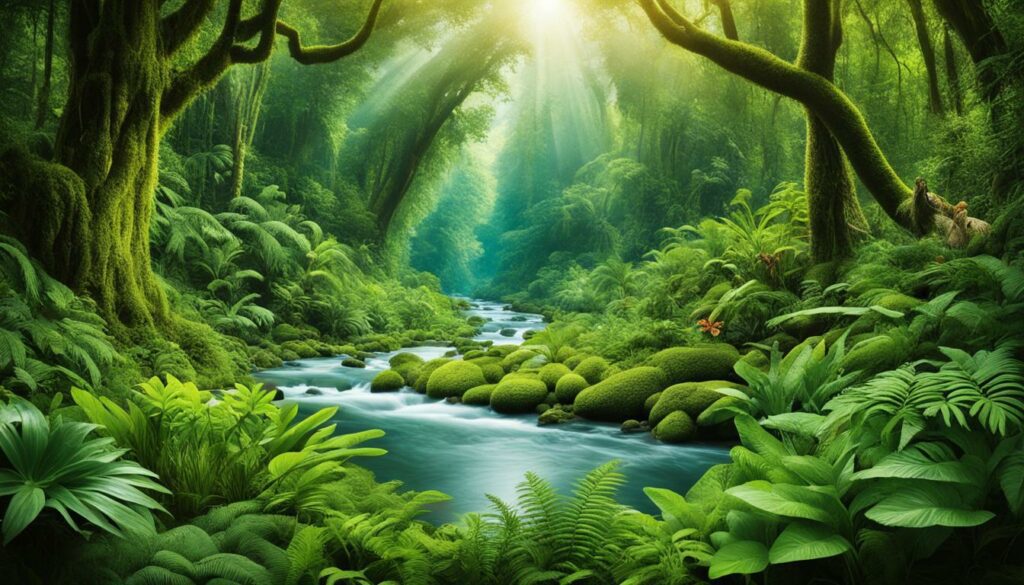
Losing biodiversity has big effects. It weakens ecosystem services we all rely on. For instance, too much logging or overfishing can harm these services.
Such harm affects not only nature but also people. Many, including tribal groups, depend on healthy ecosystems. As these areas decline, so do the benefits they provide us. This can hurt economies and societies.
We need to stop biodiversity loss. This means using resources like forests more sustainably. Green farming and careful land use can help. These methods protect plant and animal diversity.
By making these efforts part of our national plans, we can do better for nature and ourselves.
Saving biodiversity needs many strategies so we don’t use too much and help at risk species. The Addis Ababa Principles, from the Convention on Biological Diversity, guide us in many sectors. They suggest things like growing food without chemicals, using eco-labels, and promoting eco-friendly tourism.
Buying from local farms helps save our plants and animals and boosts the local economy. It also encourages methods that are good for the planet. For example, organic farming uses fewer chemicals and makes the land more resilient. Bees love it when we plant crops without chemicals and cover the land with flowers. It helps them thrive, and they’re so important because they help plants reproduce by moving pollen.
Growing plants and foods that belong in your area is great for the planet. Animals can live and find food in these areas. Using less water, like in shorter showers, helps keep the environment for creatures that need it.
Treating places like parks with care means we respect where animals and plants live. By not doing too much in these places, we can help nature keep its balance. It also really matters to check where products come from and support groups like the FSC and Rainforest Alliance. They help by making sure things are done in a way that doesn’t hurt nature.
Keeping nature safe involves taking care of it where it naturally grows and also outside these areas. Saving animals and plants where they live, like in parks, is cheaper and protects many species at once. Working to keep species alive outside their natural homes, such as in zoos, gives them a chance to go back to the wild.
Laws that protect the environment are key in these efforts. They stop harmful practices. Following these well-thought-out plans make sure we keep our environment safe for all, present and future.
Using green initiatives is key to keeping our world full of diverse life. Every group, from businesses to your local area, should work hard at this. It’s about lessening harm and boosting life variety.
Companies going green can cut down on using up our planet’s resources. By getting certified, like with Wildlife Friendly®, they help protect animals and their spaces. When you see products are FSC or Rainforest Alliance Certified, it means they come from places that look after nature. This helps you as a buyer live greener and also aids local people in saving plants and insects important for our world’s balance. Plus, it’s good for the bees, key to keeping nature diverse.

The leaders in these eco-friendly moves are making our surroundings healthier. They’re also helping make lives better for those nearby, improving places like our rivers by using less water.
Getting everyone in a group involved makes eco efforts stronger and last longer. When locals buy fresh, close-by products through schemes that help farmers, they’re not just eating well. They’re also supporting spaces that keep nature varied. People also walk where they’re told when enjoying the outdoors, showing they want to keep it safe for plants and animals.
The UN urges using natural ways to grow our world while keeping it in balance. They work on rights, fair chances, and caring for groups like indigenous people. With everyone working together, we can better our earth for tomorrow.
“Over 50 ways to use nature to help people and keep life diverse shows we’re on the right path for the earth and people. Combining saving biodiversity and helping the poor is vital.”
These green actions are about making clean, fair places to live for all. By joining in on these community projects, we’re making sure there’s plenty of life around us. And we’re setting up ways to share our world with those who come after us.
Adaptive management is key to looking after natural resources. It helps use resources in a way that can last, even when faced with unknowns. This process is all about learning and changing to make our natural world more able to cope with big changes. It combines old knowledge with new science to match how ecosystems really work.
It takes money to manage resources in an adaptable way. This money goes to studying climate, looking at what plants and animals need, and finding ways to help them survive. It’s all about making sure our natural world can handle climate changes. And it’s important to have everyone who cares involved, like local people and organisations.
Adaptive management works best when everyone joins in. This means making smart decisions that are good no matter what, and teaming up with different groups of people. Together, local leaders, landowners, and others can create places where nature can thrive. It also means fitting these ideas into other plans, so everything moves in the same helpful direction.
Looking after nature well has big benefits. It helps farms, fishing, and the water we drink. Plus, strong ecosystems lower risks from things like too much rain causing landslides. This all shows why adaptive management is a smart choice for using resources well over time. It’s all connected – caring for nature helps us too.
| Insights | Details |
|---|---|
| Network Size | The Natura 2000 network consists of approximately 27,000 sites, covering over 1 million km². |
| Climate Change Impact | Adaptive management enhances natural system resilience, aiding species adaptation to climate effects. |
| Stakeholder Engagement | Engagement of local communities and NGOs is vital for the successful implementation of adaptive management |
| Economic Implications | Ecosystems provide provisioning services crucial for agriculture, fisheries, and fresh water resources. |
| Regulating Services | Resilient ecosystems help mitigate climate risks, such as reducing landslide vulnerability in mountain regions. |
Adaptive management is essential for refining conservation practices, incorporating reflection into actions to enhance ecological outcomes and foster a culture of continuous learning.
Traditional knowledge is key in saving our planet’s diverse life. For centuries, indigenous people’s wisdom has helped ecosystems not just survive but thrive. They know the secrets of their local lands and use them wisely.
Indigenous folks have always known how to keep nature in balance. They use their wisdom to make sure resources last. Mixing their old ways with new conservation helps us save more of our planet’s life.
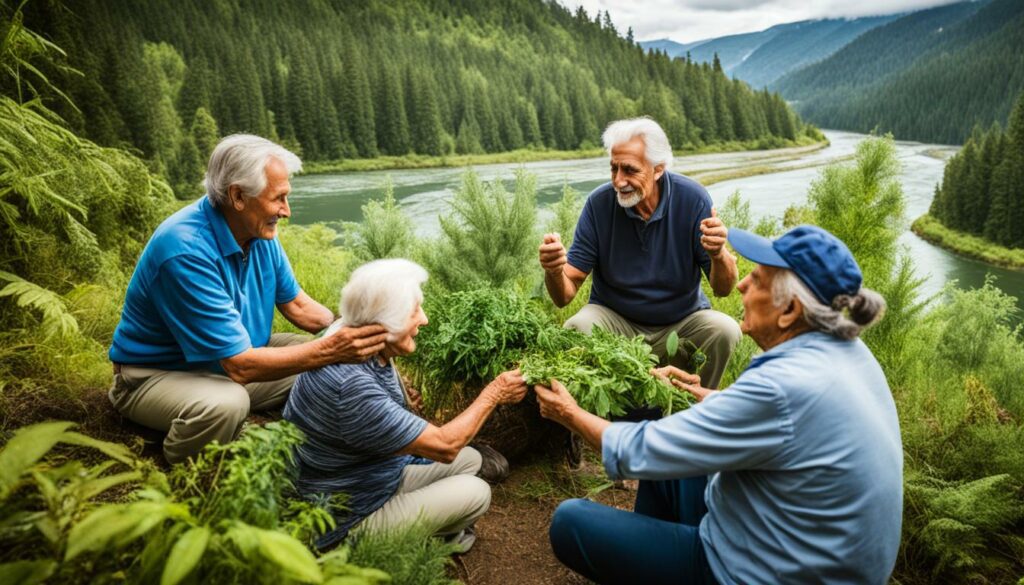
This knowledge has made a big difference in saving plant and animal life within indigenous communities. When traditional ways are used, biodiversity gets better. In fact, about 80% of the Earth’s land species are better off thanks to how indigenous people have looked after their lands.
By blending old with new, we find ways to protect nature that work for everyone. Research has shown that the old way of doing things often does a better job than new, scientific methods. By respecting and using indigenous knowledge, we’re on a path that’s good for the Earth and for people’s traditions.
Research has also found that nature cared for with traditional wisdom often has more plants and animals. This method not only helps the environment but also makes indigenous communities stronger. It’s a win-win for everyone.
Around the world, examples prove that combining old and new is fantastic for nature. When indigenous knowledge and science join hands, they do wonders for the Earth. These success stories show the power of uniting cultural ways with new ideas to save the environment.
One great example is research that mixes traditional and scientific ways to protect nature. This teamwork makes efforts to save plant and animal life more successful. It shows how powerful traditional ways really are.
| Region | Traditional Knowledge Integration | Conservation Outcome |
|---|---|---|
| Amazon Rainforest | Indigenous Land Management | Increased Biodiversity Hotspots |
| Central Africa | Traditional Agroforestry | Enhanced Ecological Resilience |
| Arctic Regions | Indigenous Hunting Regulations | Stabilized Wildlife Populations |
To sum up, traditional knowledge is a must in saving Earth’s amazing variety of life. It lets us work together for a nature that’s sustainable and good for all.
Sustainable agriculture helps keep our environment healthy for the long haul. It focuses on farming today without hurting the future. By finding a balance, we can meet our food needs and protect nature too.
Organic farming is a key part of sustainable agriculture. It avoids using chemical pesticides and fertilisers. Instead, it relies on natural ways to grow crops and manage the land. In the Guatemalan Highlands, a study found that farms using organic methods had more diverse wildlife. This shows how beneficial organic farming can be.
The study looked at farms over 192 hectares in three areas. Important organic techniques included contour farming, terracing, and growing different crops. The farms using EbA showed more than double the number of insects that play a role in farming. Their approach to farming led to more diverse insects, proving the value of organic methods.
Protecting crops from pests is crucial in sustainable farming. The approach of integrated pest management (IPM) is eco-friendly. It helps keep bad bugs in check without harming good bugs. As a result, the farms with IPM had better insect diversity and more biodiversity.
This approach supports a healthy farm ecosystem. It shows a key way to protect nature and increase farm productivity. In essence, it’s about keeping the balance within the farm environment.
Since May 2022, a project in Guatemala has been focusing on sustainable agriculture. It uses Ecosystem-Based Actions (EbA) to enhance biodiversity. Projects like this are important for healthy and productive farming areas.
Keeping our wildlife safe involves many steps. We must stop loss of different species and help those at risk to grow in number again. One key way is by creating safe areas for them. These places help protect animals and plants from being harmed by people or losing their homes.
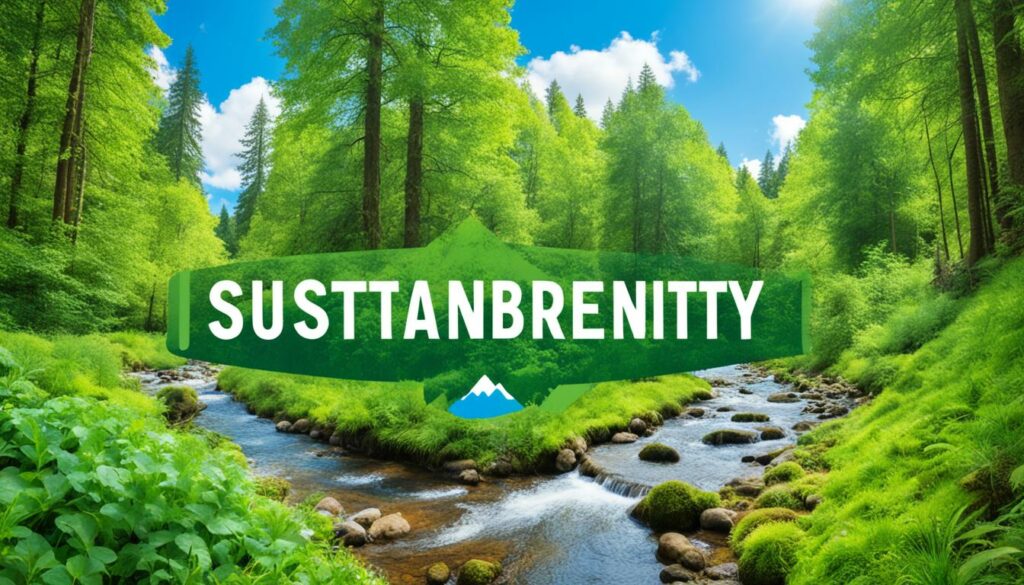
To keep animals safe, we have tough laws to stop poachers and help animals heal. The U.S. has the Endangered Species Act to protect nature, as do groups around the world. NGOs, like the WWF and the WCS, are very important too. They work hard to make sure animals and their homes are safe.
Since 1970, the WWF tells us there’s been a big drop in how many animals there are worldwide. Big animals like elephants, rhinos, and big cats are finding it harder to live because of people cutting down forests and hunting them. We need to make their homes better and keep them safe from hunters to help them survive.
To really help animals, we all need to work together. This means governments, NGOs, businesses, and the public. Even local farms can make a big difference by growing food without harmful chemicals. This kind of farming helps keep the land safe for animals. Doing this, along with planting local plants, helps nature and animals a lot.
Teaching people and making them aware is key. When we visit natural areas, sticking to paths keeps homes safe for animals and plants. Buying products from companies that don’t harm nature helps a lot too. This way, we all do our part in saving wildlife.
Species Protection Strategies:
Everyone working hard together is our best chance to protect animals and their homes. By all making effort, we can look forward to a future where the wild is still alive and thriving.
Exploring ecosystem services shows they’re key for our well-being and planet’s progress. The United Nations points out four main types: provisioning, regulating, cultural, and supporting services. These services are critical for human life and a green future.
Provisioning services give us direct benefits from nature. This includes food, water, wood, and even medicine. Did you know bees, for instance, help grow 71 out of 100 important food crops globally? In Europe, 84% of 264 crops and 4,000 plants exist thanks to bees. Protecting biodiversity is essential for our future, ensuring we keep getting these resources.
Regulating services help control our environment and health. They manage the climate, fight diseases, and clean water and soil. Natural areas like forests help moderate our climate, reducing the effects of global warming. They create the perfect conditions for both people and nature to thrive. We must preserve these critical ecosystem services for a stable and healthy world.
Restoring habitats is key in fighting biodiversity loss and harm to ecosystems. It involves using different methods to help nature recover. This way, we can make our environment stronger and better.
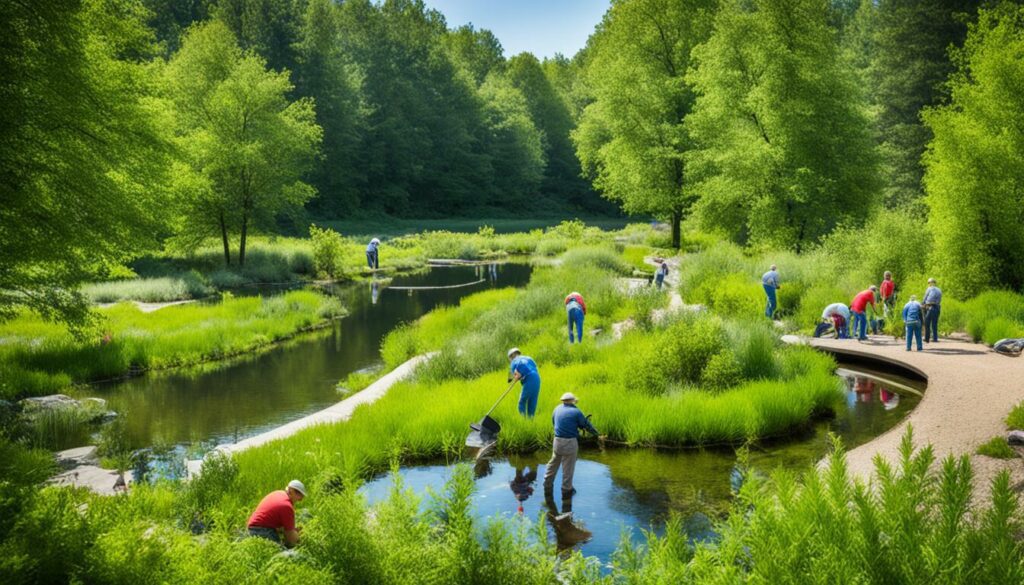
Reforestation plays a vital part in habitat restoration. It works to fill forests with trees again after a lot have been lost. From 2000 to 2020, the planet lost nearly 100 million hectares of forests. Through planting native trees, we counter this loss. We also help capture carbon and protect different species, boosting their numbers and variety.
Reviving wetlands is also crucial. About 85 percent of them are in bad shape. But these areas are important for clean water, controlling floods, and as homes for many plants and animals. To bring them back to life, we have to get rid of harmful plants, put back the local greenery, and fix the water’s natural flow. This way, we improve these places and make them better at supporting nature.
Both reforestation and wetland restoration are critical for bringing nature back. They’re key parts of our big plan to heal the Earth from human harm. Through these efforts, we make natural places stronger and more diverse. Involving local people and using new ideas is helping make these projects succeed.
Sustainable fisheries management aims to keep the economy and nature in balance. It tries to avoid overuse, protecting marine life for the future. By using good methods, we can keep our seas healthy.
Fisheries set clear fishing limits to avoid overfishing. Strict rules are vital. For example, NOAA looks after U.S. waters, making sure fishing doesn’t harm the ocean too much. This helps in keeping our marine life safe.
| Fishing Method | Impact |
|---|---|
| Purse Seining | Can catch thousands of fish at once, leading to overfishing |
| Longlining | Catches hundreds to thousands of fish, often resulting in significant bycatch |
| Rod-and-Reel | Results in less bycatch and is considered more sustainable |
Marine Protected Areas (MPAs) are key to protecting marine life and its variety. These areas help fish stocks to grow by themselves. Thus, MPAs are important for a sustainable, undisturbed ocean life.
About 35% of world fisheries are overused or heavily fished. By using fishing limits and protection zones, we can help the sea recover. This shows that we need many actions to manage the sea well, working together across the globe.
Keeping human-wildlife conflict low is key to both human needs and nature conservation. As people move into animal areas, trouble grows. This makes it hard to protect wild animals. We need smart plans to live together and tackle these big problems.
Research shows that our actions lead to more animals dying out. Around 1 million types of plants and animals are at risk now. The latest figures show over 42,100 species are in trouble. It’s urgent we deal with these clashes for the sake of our natural world. Saving ecosystems and keeping species alive are essential. If we want to stop species from dying out because of us by 2030, we must act. This means things like bringing animals back, giving them shots, and protecting their homes are very important.
In Namibia, there were more than 8,000 run-ins between people and animals in 2017. In Europe, where wolves, bears, and lynx attack sheep, thousands are lost every year. India faced over 1,700 deaths because of elephants between 2015 and 2018. These numbers show a serious need for strong plans to help both people and animals live together.
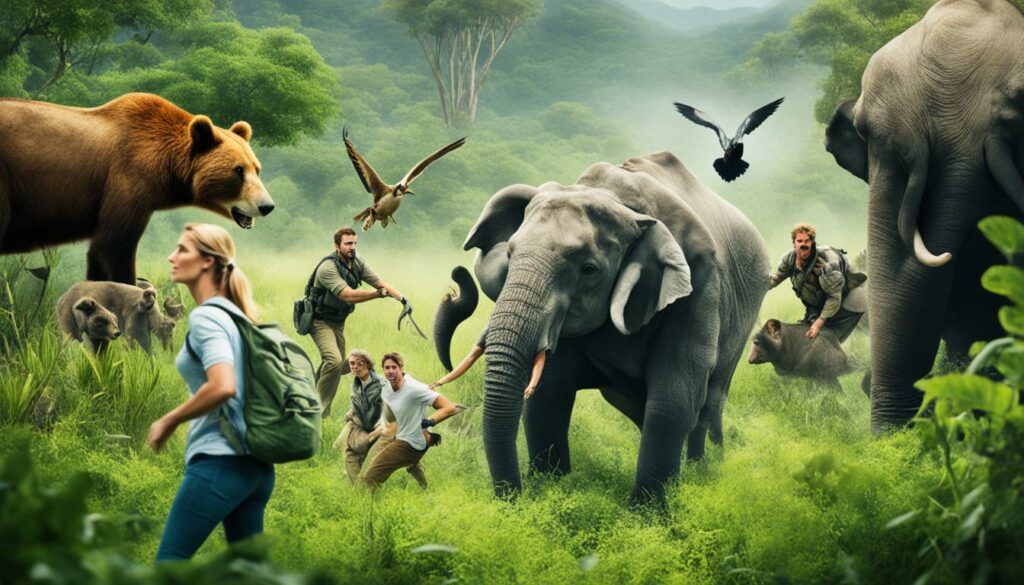
It’s vital to use good plans to keep animals from hurting people and vice versa. Ways like using guards, fences, and smells that animals don’t like help a lot. Also important are money and jobs for people affected. Getting everyone involved makes these ideas work better. Although each method alone might not change a lot, together they make a big difference.
Looking at the big picture and finding ways for people to protect themselves and nature is crucial. Sharing success stories about protecting nature helps everyone make better choices. This leads to a future where people and wildlife can both thrive.
| Region | Conflict Incidents | Human Fatalities | Challenges |
|---|---|---|---|
| Namibia (2017) | 8,000+ | High | Human-wildlife conflict management |
| Europe | Tens of thousands | Medium | Sheep predation by wild carnivores |
| India (2015-2018) | 1,700+ | 370 | Human-elephant conflicts |
| Global | Widespread | Varied | Extinction risk and habitat loss |
Effective policy is key in protecting our planet’s biodiversity. Local and global policies guide the efforts to keep our natural spaces safe. Take, for instance, the UK’s Overseas Territories. They have their own rules and get help from the UK to save their unique wildlife.
Having strong policies is not enough. They must work on national and global scales. Since the late 1990s, the UK’s Overseas Territories have made their own choices about nature. This setup lets them focus on what their local environments need. But, they face problems with old laws and not enough checks on these laws. Interviews with experts show that having enough people, money, and facts is critical for the success of these policies.
Looking at successful examples teaches us a lot about saving nature. Costa Rica, known for its rich biodiversity, is a standout. It has rebuilt forests through strong policy. Its efforts have turned once barren lands lush again. Costa Rica has also protected important marshlands under international agreements, covering over half a million hectares.
To wrap up, hearing about wins in different places can inspire us. These stories show that strong policies and following world agreements offer a winning strategy. By working together at national and global levels, we can ensure our natural world thrives.
Exploring the importance of conservation monitoring shows it’s key for conservation success. We check the effectiveness of various strategies through biodiversity assessments and ecological impact evaluations. This helps us make changes for better conservation outcomes.
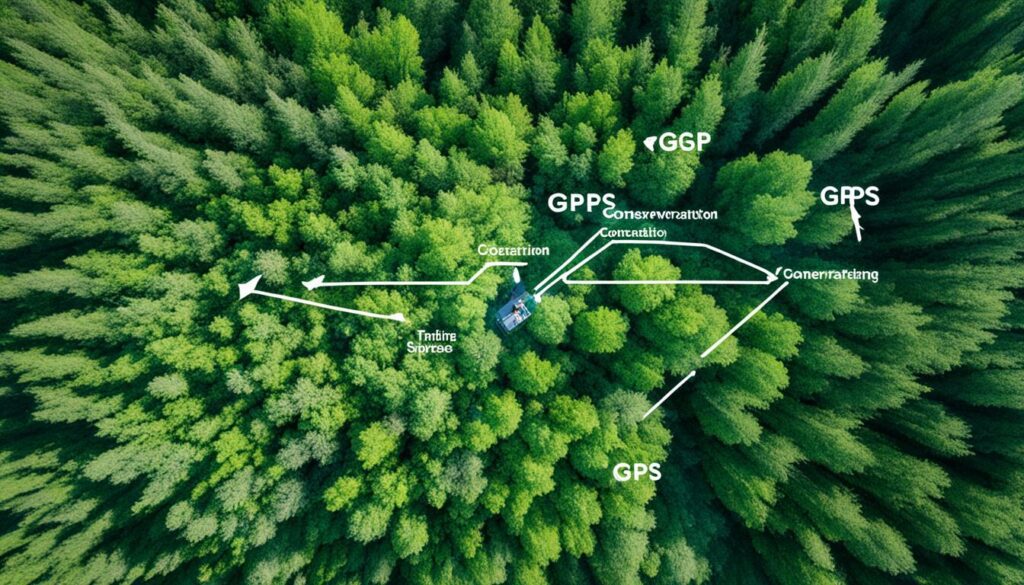
Globally, there are nearly 300,000 protected areas and conservation measures. These are crucial for meeting Aichi Biodiversity Targets. Among these is the goal to conserve 17% of earthly areas and 10% of coastal locations. Such efforts underline the need for strong monitoring.
The 2011-2020 Convention on Biological Diversity aimed to stop biodiversity loss. It set out 20 Aichi biodiversity goals like Target 17, which focused on national action plans. This highlights the need for detailed monitoring.
The Kunming-Montreal Global Biodiversity Framework sets targets needing checks and assessments. For example, it aims to restore 30% of damaged ecosystems and protect 30% of the planet. Meeting these ambitious goals needs ongoing checks to find improvement areas.
Adaptive management provides a way to be flexible and learn as we go in conservation. It uses innovative technologies for quick biodiversity assessments. This helps in making on-time decisions for better conservation results.
“Adaptive management improves resource management by considering uncertainties in biological systems.”
Citizen science, like iNaturalist and eBird, plays a big role in monitoring. They involve the public, providing key biodiversity data. Also, new techniques like environmental DNA are vital for gentle species and habitat checks.
Recognising the effects of these efforts, think about the benefits for climate and governance. The tables below show the efforts needed for climate and governance benefits.
| Illustrative Indicators for Climate Mitigation Benefits | Subjective Measures of Effort |
|---|---|
| Reduction in Greenhouse Gas Emissions | High |
| Increased Carbon Sequestration | Moderate |
| Illustrative Indicators for Governance Benefits | Subjective Measures of Effort to Collect Data |
|---|---|
| Policy Implementation Success | High |
| Stakeholder Engagement | Moderate |
To end, with careful conservation monitoring and biodiversity assessments, we can understand and act on ecological impacts. This approach leads to lasting conservation outcomes.
It’s vital to tackle conservation challenges to protect biodiversity. Things like habitat loss, cutting up land, and climate shifts stress our ecosystems. Human actions, including cutting down forests, building towns, and farming, make these problems worse. This leads to the fast loss, breaking up, and harm of nature. Also, invasive species are a big issue. They beat local plants and animals and change the land, reducing the variety of life there.
Climate change makes these tasks even harder. It mixes up where species live, messes with how they survive together, and impacts important events like travel and having babies. Also, we’re using up too much from the natural world, like fishing too hard and killing too many animals. This is lowering their numbers and making extinction more likely.
There are big hurdles in the way of conserving nature. These include not enough support from leaders and a lack of money. Some governments care more about swift money gains than keeping the earth healthy for the future. But, these difficulties do offer some chances for new ideas and steps forward in helping biodiversity to grow and diversify.
More people pushing for change is key. This needs both wider understanding and real actions from everyone, groups, and authorities. For example, creating a system like the Rwenzori Score to check how well waters are supports the idea of using new measures for each area.
Connecting efforts to save nature with wider sustainable development goals is a big change. It means trying to help nature while also helping people and society in general. Methods like looking at how local cultures and nature are connected, and planning clever ways to fight climate change, show a way. They aim to meet both the earth’s and society’s needs at once.
Using the chance of more people caring and working towards global aims can turn the trouble in saving nature into big wins. This way, we can make sure to keep Earth’s diverse life safe for those who come after us.
| Challenge | Impact |
|---|---|
| Habitat Loss | Leads to fragmentation and degradation of ecosystems |
| Climate Change | Alters species distribution and ecological interactions |
| Invasive Species | Displaces native species and alters ecosystems |
| Overexploitation | Causes population declines and increases extinction risk |
The journey to protect biodiversity is hard but vital. We’re at a critical point, facing big changes in nature. It’s key to see how our actions affect the environment. Much of the earth is used for farming or grazing because of us. This makes it very urgent to manage things more sustainably.
We heavily impact around 80–90% of livable lands. 1.1 billion people live in areas important for nature, relying on agriculture. This makes it clear that we need to manage the environment better. Green efforts, supported by things like tax breaks, are vital to help protect nature.
Protecting wildlife faces big threats like losing its homes, being overused, pollution, and climate change. We’re losing species much faster than usual. To slow this down, we must work together with smart plans. Using what we know, adapting, and setting strong rules can protect nature. This way, we help both nature and us to grow.
Finally, it’s up to all of us to choose ways that care for our planet. Through green projects, we can really change the future for wildlife. By working together and thinking about the big picture, we can leave a healthy planet for those who come after us. It’s time to step up, ensuring a better future where nature and people can flourish.
Sustainable biodiversity practices use natural resources in ways that don’t harm the Earth’s ability to renew them. They balance the needs of current and future years.
This includes reducing waste, adjusting how we manage things, and using knowledge from the past.
Biodiversity helps ecosystems provide for us and boosts our economies. It helps with things like keeping the climate right, moving nutrients around, and making soil.
All these help humans, nature, and the economy work well together.
The CBD guides how we should work with nature in areas like farming, wood cutting, fishing, and travel. It wants countries to make sure their rules promote health and strength in nature.
Green projects and acts of conservation by local people help minimise our impact on nature. For example, getting the Wildlife Friendly® seal means a business is looking after nature while they work.
Adaptive management is about always learning and fine-tuning our ways. It meets the challenges nature throws with a mix of our old and new know-how.
What our ancestors knew can still help protect plants and animals today. The wisdom they passed down is great for looking after our natural home.
Organic farming keeps harmful chemicals away, focusing instead on natural ways to grow food and care for the land. This keeps farming safe for the long run and supports our planet.
To keep animals safe, we make ‘safe zones’, stop illegal hunting, and help animals heal. These steps are key for protecting nature as we know it.
The Earth’s systems give us many perks like food and clean water. They also keep our climate in check and our water fresh. These gifts keep us and our environment well.
By bringing back natural homes, we turn around the loss of life and space in nature. These actions help plants, animals, and the land stay strong and diverse.
To make sure the seas stay full of life, we fish in a smart way. This includes rules and other tools to fish without hurting the ocean.
Keeping peace between humans and animals means saving where they live, getting everyone involved, and solving problems fast. These keep both people and animals happy and healthy.
Laws at home and around the world guide how we look after nature. Following these well is key to making our efforts work and inspiring others to do the same.
Watching and checking on our work helps us see what’s going right or wrong. This feedback helps us adjust our actions for the best results, pushing us towards our goals.
The loss of homes and climate change are tough challenges, but more people wanting to help and progress towards going green gives us hope. Helping nature also helps us move forward as a society.